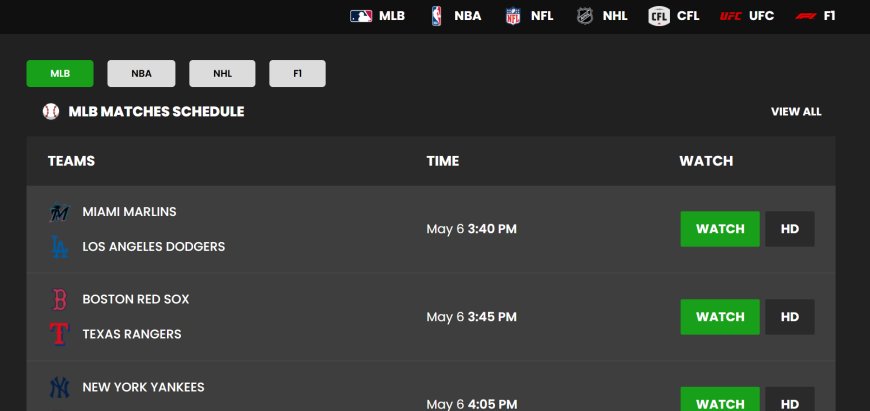The Stream Surge: How Sports Live Broadcasting is Reshaping the Digital Era
With the growing demand for instant, high-quality content, sports live streaming has emerged as a dominant force, reshaping how fans connect with their favorite teams, athletes, and competitions

In the fast-paced digital age, the way we consume content has drastically changed, and nowhere is this transformation more evident than in the world of sports. With the growing demand for instant, high-quality content, stream surge sports live streaming has emerged as a dominant force, reshaping how fans connect with their favorite teams, athletes, and competitions. The "stream surge" is not just a trend—it's a revolution in the entertainment and broadcasting industry.
The Rise of Sports Live Streaming
Live sports broadcasts have long been a staple of television networks, but the shift to digital platforms has redefined the game. In recent years, more viewers have migrated from traditional cable to online streaming platforms, drawn by the flexibility, convenience, and interactive features that digital streaming offers.
The sports live experience today isn't just about watching a game—it's about being part of a global, real-time community. Platforms like ESPN+, DAZN, Amazon Prime Video, and regional sports networks now offer sports fans the ability to stream live matches from virtually anywhere in the world. Whether it's football, basketball, tennis, or even niche sports like MMA or esports, the stream surge has made it easier than ever for fans to stay connected.
Explore More :
Sportsurge: The Rise of the Sports Streaming Surge
What Drives the Stream Surge?
Several factors are fueling the current stream surge in sports live broadcasting:
-
Mobile Accessibility: With smartphones becoming more powerful and internet connectivity improving, fans can now watch live games on the go. This flexibility is a major driver behind the surge in sports streaming.
-
Social Media Integration: Live clips, in-game highlights, and interactive chats during matches enhance the overall experience. Platforms like Twitter and YouTube have made real-time interaction a key feature of sports live content.
-
Global Reach: A fan in Tokyo can watch an NBA game live from New York without delay. This global accessibility has broadened the fan base for many leagues and sports.
-
Customized Viewing Experience: Streaming platforms often offer multiple camera angles, language options, and even data-driven insights during the match. Fans can tailor their viewing experience to their preferences.
-
Subscription Models: Many platforms offer affordable or even free sports live streams, making it easier for fans to access content legally and conveniently.
Economic Impact of the Stream Surge
The shift from traditional broadcasting to digital has had significant economic implications. Sports leagues are now negotiating multi-billion-dollar streaming deals. For example, the NFL's agreement with Amazon to stream Thursday Night Football is a testament to how seriously organizations are taking digital distribution.
Moreover, advertising models have evolved. Brands now integrate ads in a more targeted manner through digital platforms, enhancing ROI and creating more personalized ad experiences for users. This stream surge has opened new revenue streams for both platforms and sports organizations.
Challenges of the Digital Transformation
While the stream surge has brought numerous benefits, it also comes with challenges:
-
Latency Issues: A common complaint among viewers is the delay between real-time action and the digital stream. For passionate fans, even a few seconds can spoil the experience—especially when social media might reveal a goal or point before they see it.
-
Piracy and Illegal Streams: The proliferation of pirated sports live streams remains a major issue. Leagues and broadcasters are investing in advanced tech to curb illegal streaming and protect their rights.
-
Content Fragmentation: With different sports spread across multiple streaming platforms, fans often need to subscribe to several services to access all the content they want. This fragmentation can lead to viewer fatigue and added costs.
The Future of Sports Live Streaming
The stream surge is only just beginning. As technology continues to evolve, the sports live experience will become even more immersive. Innovations like augmented reality (AR), virtual reality (VR), and 5G are expected to further enhance the way fans interact with live content.
For instance, imagine watching a football game in VR, where you feel as though you're sitting at the stadium. Or getting real-time stats and player tracking on your AR glasses as you watch a tennis match live. These advancements are no longer science fiction—they are actively being developed and tested by major tech companies and sports leagues.
Additionally, the role of artificial intelligence and machine learning in delivering personalized content recommendations and automated highlights is becoming increasingly prominent. Fans won’t just watch sports—they’ll experience them in ways never before possible.
Conclusion
The stream surge has transformed sports live viewing into a dynamic, interactive, and global experience. No longer limited to TV screens, sports content now lives in our pockets, travels with us, and engages us on multiple levels. As the industry continues to innovate, fans can expect even more exciting ways to experience their favorite sports in real-time.
The intersection of sports and streaming technology is shaping a future where accessibility, personalization, and immersion define the viewer experience. Whether you're a die-hard supporter or a casual fan, the sports live revolution ensures that the thrill of the game is always just a click away.

























































































































































